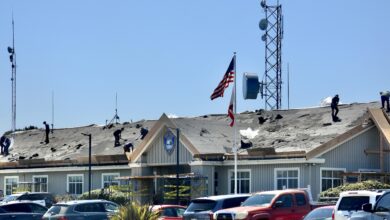Fishermen get financial relief, launch study of disaster impacts
For Telstar Charters owner Randy Thornton, federal salmon disaster relief money will literally be salvation for his charter boat business.
But as part of a new committee on salmon closure impacts, he hopes to help show how the catching of the tasty pink fish impacts the entire coastal economy.
The North Coast Fishing Association is organizing the committee to assess community-wide impacts from the loss of recreational and commercial fishing. In addition to fishermen, the group will consist of hotel owners, restaurateurs and representatives of other tourist dependent businesses.
In the absence of information about the wider impacts, Fort Bragg”s fishing has often been closed while other areas have been allowed to stay open, Thornton said.
“Rockfishing was closing here but allowed south of Point Arena … The reason is the perception of greater economic impacts there. The total economic impact on the Bay Area is big. There are 10 times as many boats there as there are here,” Thornton said.
“But per capita, the closures probably hurt more in places like Fort Bragg, Eureka and Trinidad, because we don”t have the variety of options to choose from as an economy,” Thornton said.
The NCFA hopes the new committee will quantify the impact on the entire town so that information can be presented the next time closures are considered.
Thornton has already mailed his request for the current round of federal relief. The first checks will be released on Oct. 1, according to a Pacific States Marine Fisheries Commission press release.
“The relief money will save my business for sure … Talk is cheap ? I will believe it when the money is in the bank,” Thornton said.
One worry of fishermen right now is that the Bush Administration has diverted $70 million from the $170 million in relief. The relief package is for Oregon, Washington and California for a period of two years.
The $70 million was diverted to pay for cost overruns in the preparation of the 2010 census. While the money was “borrowed,” it is unclear when or how the money will be put back.
Congressman Mike Thompson of St. Helena, along with 11 other members of Congress, wrote to President Bush on Sept. 19 urging him to distribute the full $170 million in disaster aid to those whose businesses that were hurt by the collapse of the Sacramento River fall run Chinook salmon population.
“The Bush Administration has once again put politics ahead of people. Because of the Administration”s disastrous policies Pacific coast fishing families have been devastated,” Thompson said in a press release.
“Congress appropriated $170 million in federal disaster relief, but this latest proposal by the Bush Administration to withhold a large portion of these funds shows no regard for hardworking fishing families nor their livelihood.”
A National Oceanic and Atmospheric Administration press release simply said $100 million was being released, making no mention of the other $70 million.
Of the initial $100 million, $63 million will go to California, $25 million to Oregon and $12 million to Washington. The breakdown is based on the projected economic impacts of the fishing shutdown in each state.
Jim Martin of the Recreational Fishing Association (RFA) says his group lobbied for the badly-needed money.
“The RFA supports the relief money because Noyo Harbor is at risk of losing critical infrastructure needed to maintain a fishing community,” said Martin. “Our charter fleet, marine repair facilities, and the harbor itself have been hanging on by a bare thread. These funds come just in time to preserve these businesses.”
Thornton worries that 2009 (when another Sacramento River salmon disaster is predicted) may be when the problem with the diversion hits.
“It”s like everything else in the economy right now — spend the money now and think about it later,” Thornton said.
Relief application forms were mailed last week to commercial fishermen, processors, wholesalers and charter boat owners.
Application forms can be downloaded from the PSMFC Website, www.psmfc.org, or obtained by contacting the California Salmon Disaster Relief Hot Line at 1-877-695-3457.
To qualify, one must have purchased a business license or permit in 2007 or be a current permit holder.
Charter boat owners like Thornton are being paid $85 per head for the total number of fishermen on their charter boats in the best of the last five years.
“The Fish and Game logs that I turn in were all I needed. Thankfully, I have done that religiously for the past 21 years,” he said.
Thornton says the salmon money will pay his bills if not allow him to expand and improve his business as he had hoped to do. The Telstar may have been hurt more by the drastic shrinking of the rockfish season from 12 months to three months. Thornton had built a successful trade in winter rockfishing that vanished this year with no payments.
“The shortening of that season plus the higher price of fuel spells disaster,” he said.
Last Saturday, Thornton participated in a Department of Fish and Game approved experimental deep water rockfishing trip, one of the measures the department has taken to help those hit hard by the closure.
Rockfish numbers have plummeted near shore. But Thornton was allowed to fish in 1,100 feet of water for the bright red rockfish commonly known as “chili peppers.” A DFG observer was aboard. Thornton got 10 customers for the trip, but nobody caught any chili pepper fish.
Instead, they hooked many giant squid, which fight with a fury unparalleled in most fish. Most of the big Humboldt Squid managed to escape the line before being landed but a 13-pounder was reeled in.
Giant squid are considered excellent eating, and the Humboldt Squid is not a protected species. Thornton thinks he may offer squid-crab combo trips in the future.
But innovation can”t replace the spectacular power and beauty of salmon in the local economy, fishermen say.
“Salmon has always been about 70 percent of our business. People come from near and far because of our salmon. It is one of the healthiest fish to eat and a great fighting fish when you get one on the line,” Thornton said.
Eleven years ago Thornton bought the Telstar and recently made the last payment. He once fished 200 days out of the year, with the most time spent on rockfish, the species that kept anglers happy in March and April of years past.
The bad news has been known all year but started officially on May 1, when the NOAA closed the salmon fishery in California and most of Oregon. The closure is due to the unprecedented and stunning decline in salmon returning to the Sacramento River. The closure was the worst commercial and recreational fisheries failure in both California and Oregon history, and is the first ban on salmon fishing since the industry began 150 years ago.
There may have been just one big salmon caught locally in Fort Bragg in 2008.
Captain Tim Gillespie of the Sea Hawk brought one very lucky fisherman to the Advocate-News office for a picture of a rare early spring landing.
Few fish are caught early in the year with June through September the prime local fishing season.
Washington, Oregon and California estimated $290 million in total damages to the West Coast fishing industry. Congress approved $170 million in relief money for the three states.
Then an unrelated problem popped up.
In June, the White House requested $546 million more for the census, and then borrowed $70 million of the $170 million in salmon disaster money allocated in the Farm Bill to pay for the cost over-runs. The Harris Corporation, a Florida defense contractor, has run into hundreds of millions of dollars in cost overruns for the census. Thompson says Bush ignored warnings about the census problem from him and other members of Congress.
Thornton says he and most other fishermen have to be tough and determined to survive the gut-wrenching ups and downs, the often mysterious and contradictory science and the endless political battles.
“I have had a tremendous struggle to get where I am …,” Thornton said. “Something always seems to come down the road that keeps me going. Thank God for that.”
With many others, he looks forward to a spectacular 2010 salmon season, when predictions are for a big return of both fish and pent-up fishermen. He has considered buying a second boat for that year”s fishing.




